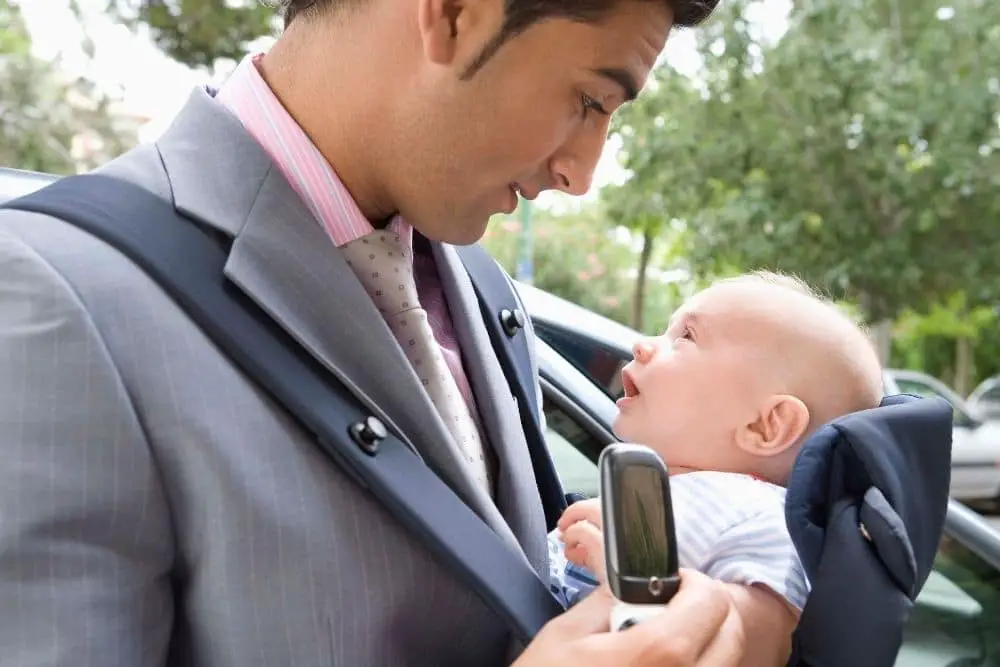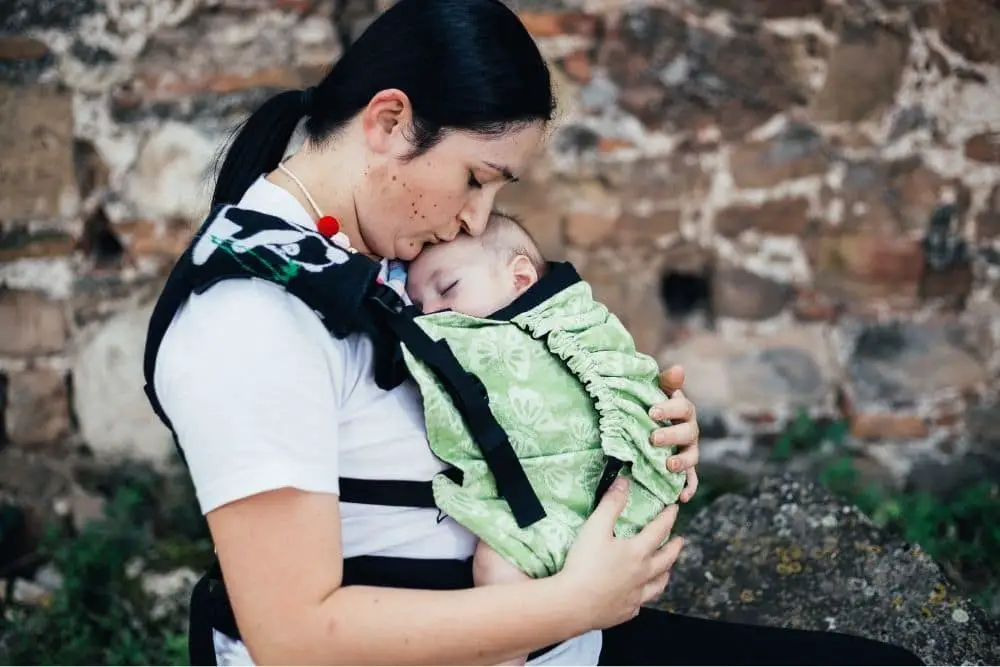If you are expecting and looking for a way to carry your baby, you might be thinking about getting a baby carrier. But should you?
The question may come to your mind “Is a baby carrier safe for newborns?“
Some parents think they can’t use a baby carrier until their baby is six weeks old or older, or they choose to wait until then.
A baby carrier can be used from the day your baby is born as long as they weigh at least 7 pounds.
In case they are less than 7 pounds, you can use an insert.
It’s vital for babies to feel close to their parents, which can be done by holding them in your arms. But you cannot do that for more extended periods, whereas with a baby carrier, 4 hours or more is not difficult.
However, there are certain things you must be careful about while using a baby carrier with a newborn or tiny infant.
This article discusses the various problems that might come with using a baby carrier, like Hip Dysplasia, carrying positions, breathable fabric, birth weight, risk of suffocation, a problem with neck muscles, the type of carrier you should use, and a host of other questions.
There is no doubt that using a baby carrier will be a great convenience as it frees up your hands, and you can do other household work or look after other children while your newborn is safely bound to you.
Moreover, using a baby carrier may soothe a fussy newborn or help the baby with reflux.
Hey! By the way… any links on this page that lead to products on Amazon are affiliate links and I earn a commission if you make a purchase.
Thanks in advance – I really appreciate it!
Table of Contents
- Here are TEN things you need to consider
- Carry the baby in a proper ergonomic position
- Don’t tighten the straps too much
- The baby must be in an upright position
- Keep your child out of direct sunlight or cold weather
- The face of the baby should be visible
- Be careful while carrying your baby with a carrier
- Check all carrier fasteners.
- Use an infant insert if necessary
- What types of baby carrier should I use for a newborn?
- Is there any potential risk associated with using a newborn baby carrier?
- Conclusion
Here are TEN things you need to consider
Carry the baby in a proper ergonomic position

The International Hip Dysplasia Institute has suggested that the best position for the baby in a carrier during the first few months is the position is known as the “frog position.”
( also called the “spread-squat position, straddle position, or jockey position”).
In this position, the knees and hips are bent, and the thighs are supported.
Hip movement should be free. Moreover, hips should not be forced together.
The baby’s legs should be in the position of M.
This position proves beneficial for good hip development and may prevent the baby from hip dysplasia and dislocation.
The arms should be inside the carrier for newborns, but as the baby grows and develops neck control, the arms can be put out.
Your baby’s arms should not be stuck out. If they are, your child is at risk for shoulder dislocation.
Don’t tighten the straps too much
Don’t strap the infant tightly so that it forces the spine, hips, and knees to get straightened too early.
The spine should be in a C-shape, which is the natural shape.
As the baby grows, his neck control develops, and his spine strengthens naturally.
Ensure the infant isn’t forced chin-to-chest so that he is unable to straighten out.
The baby must be in an upright position
Hold newborn babies upright so they can breathe correctly and grow.
The back panel should be at an appropriate height and gives proper support.

Keep your child out of direct sunlight or cold weather
Make sure the infant is protected from harsh weather – direct sunlight or cold drafts.
The face of the baby should be visible
You should be able to see your newborn’s face at all times. At least the top of the baby’s head should remain above your shoulder to ensure that the airway is open.
The baby should be sitting upright with his neck supported, airways open, chin off his chest. You should be able to kiss your infant on his head.
You will also be able to see if your baby is squirming due to discomfort and appropriately adjust his position or loosen the straps, if necessary.
Be careful while carrying your baby with a carrier
It’s essential to know how to use your carrier correctly, so you don’t have a fall and hurt yourself or your child. Always remember to practice caution when carrying babies in certain situations like climbing stairs, using escalators, and walking on uneven surfaces

Check all carrier fasteners.
Always make sure the buckles, snaps, and wraps are securely fastened into place to keep your baby safe.
Use an infant insert if necessary
Neck support is important for your newborn. It would be best if you either used a newborn insert in your carrier or a newborn-specific carrier.
What types of baby carrier should I use for a newborn?
The type of baby carrier you should use for a newborn depends on your comfort level, the age of your child, and the price tag.

A newborn to six-week-old newborn or less will need a soft structured carrier with an insert or a buckle carrier.
A 6+ week old needs a structured carrier without an insert. These carriers are suitable because they allow airflow and do not restrict movement.
The downsides are that they can be hot and sweaty, pricey, not as comfortable for parents who have back issues and most do not have integrated support for bottles/sippy cups.
An economical alternative is a front carry blanket sling which can also be used until 6+ weeks old.
I recommend using a structured baby carrier like the Boba.
There are a few different brands, but this one is my favorite. The Boba is made of 100% breathable cotton and has an adjustable waistband to control how much your child will be able to kick in it while they are in the carrier.
There is a wide choice of baby carriers, some of which are usable for newborns.
The Adapt Cool Air Mesh by Ergobaby is a buckle carrier that newborns can use. Wraps and ring slings can also be used for newborn babies.
Certain soft structured carriers are also suitable for newborns but may require an infant insert if the baby is underweight. For newborns, buckle carriers are preferred as they don’t need any infant insert. They are also more suitable for newborns and are less bulky and hot.
Is there any potential risk associated with using a newborn baby carrier?
The baby can get overheated in hot weather, even if the carrier is breathable.

As babies are very delicate, they do not sweat, and their bodies rely on a hot environment to regulate their body temperature. When it gets too hot in the carrier, babies become distressed and tend to lose concentration on sucking, leading to dehydration 2-3 hours post-feeding.
The other risk is about the baby’s neck. The baby’s neck should be straight, even when he is facing forward. The baby should never be forced to have his head tilted back or forward,
even for a short period.
Conclusion
Baby carriers are an excellent way of carrying your newborn, and it can be a comforting experience to the both of you. It is important to follow the suggestions and advice given above and take into consideration any potential risks that you may face with using it.
Professional Carrying Consultant Emily Williamson says that “yes baby carriers are safe for newborns.”
She also states that if you are carrying a newborn, you must make sure that whatever make or model of baby carrier you are using fully supports your baby’s head and airways.
She also adds: “Babies born prematurely and with a low birth weight are at greater risk of suffocation. Take extra care, and seek advice from a health or carrying professional before using your carrier.”




1 thought on “Is baby carrier safe for newborns?”
Comments are closed.